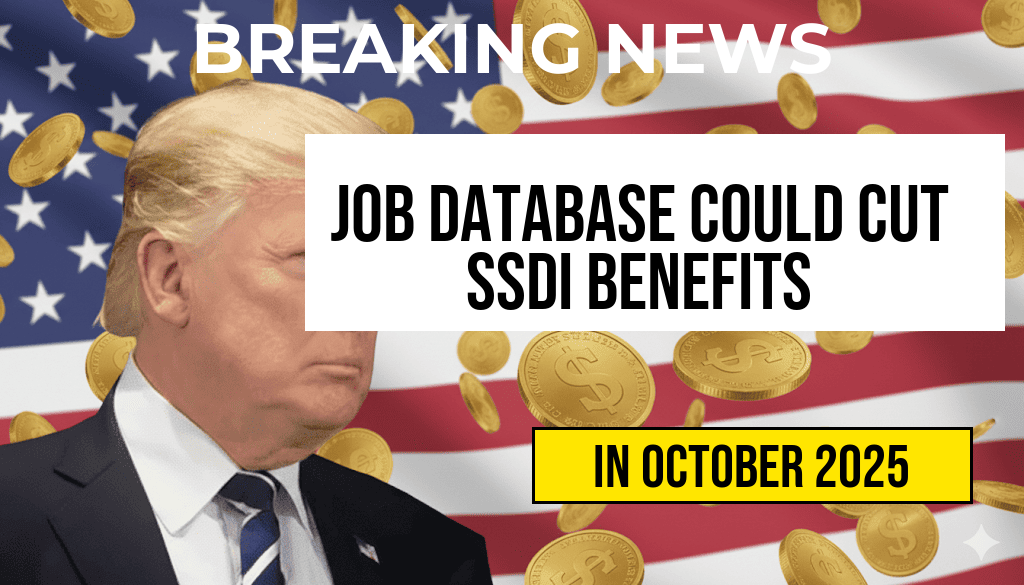A new job database, recently launched by the Social Security Administration (SSA), could drastically impact the financial support provided to many individuals aged 50 to 59 who rely on Social Security Disability Insurance (SSDI). The database is designed to assess job availability across various sectors and is expected to identify positions that individuals with disabilities might be able to fill. However, for many beneficiaries within this age group, the implications may result in a substantial reduction or even complete elimination of their benefits. As the SSA integrates this database into its evaluation process, concerns are mounting about the potential consequences for vulnerable populations.
Understanding the New Job Database
The SSA’s job database aims to provide an updated overview of available employment opportunities, particularly for those receiving SSDI. By analyzing job descriptions, requirements, and local employment trends, the SSA intends to match beneficiaries with potential job openings that align with their skills and capabilities. This initiative is part of a broader effort to encourage workplace participation among individuals with disabilities.
How the Database Works
- Data Collection: The database aggregates information from various industries to create a comprehensive picture of the job market.
- Job Matching: Beneficiaries are assessed based on their qualifications and the nature of their disabilities to identify suitable employment opportunities.
- Benefit Reevaluation: If individuals are found to be capable of working, their SSDI benefits may be reduced or terminated.
Potential Impact on SSDI Beneficiaries
The shift towards using the new job database raises significant concerns regarding the financial security of SSDI recipients aged 50 to 59. Many in this demographic may face unique challenges that could hinder their ability to secure employment, including health issues and age-related barriers.
Who Might Be Affected?
According to recent statistics from the SSA, approximately 1.4 million individuals aged 50-59 receive SSDI benefits. A substantial portion of these individuals may be at risk of losing their financial support due to the new job assessment criteria. The following groups are particularly vulnerable:
- Individuals with chronic health conditions limiting their work capacity
- Those who have been out of the workforce for an extended period
- People facing age discrimination in hiring practices
Reactions from Advocacy Groups
Advocacy organizations are voicing strong opposition to the implementation of the new database, arguing that it places undue pressure on individuals who may not have the ability or opportunity to work. Many fear that the changes could exacerbate financial instability and lead to increased poverty rates among older SSDI beneficiaries.
Statements from Experts
Experts in social policy and disability rights emphasize the need for a more nuanced approach when evaluating the work capabilities of SSDI recipients. They argue that the SSA should consider the unique challenges faced by older adults and ensure that necessary supports are in place before making any cuts to benefits.
Alternatives to the Current Approach
Some suggest that rather than focusing solely on job placement, the SSA could adopt a more holistic strategy that includes:
- Job Training Programs: Providing resources for skill development tailored to individuals with disabilities.
- Flexible Work Arrangements: Encouraging employers to offer part-time or remote work options for older beneficiaries.
- Support Services: Enhancing access to counseling and job placement services to better serve this demographic.
Looking Ahead
As the SSA begins to implement this new job database, the potential ramifications for SSDI beneficiaries aged 50-59 remain a topic of intense debate. Stakeholders are urging the administration to consider the broader implications of these changes and to prioritize the well-being of individuals who may be disproportionately affected. The ongoing discussions will be crucial in shaping the future of SSDI and the support it provides to those in need.
For more information on SSDI eligibility and the new job database, visit the Social Security Administration or read about it on Forbes.
Frequently Asked Questions
What is the new job database mentioned in the article?
The new job database is a system designed to track job opportunities and employment data, which may impact the eligibility and amount of SSDI (Social Security Disability Insurance) benefits for individuals aged 50-59.
How could the new job database affect SSDI benefits?
The database may identify job openings that individuals in this age group can perform, potentially leading to a reduction or even elimination of their SSDI benefits if they are deemed capable of working.
Who is most likely to be affected by these changes?
Individuals aged 50-59 who currently receive SSDI benefits and are assessed for their ability to work may be most affected, especially if they are unable to find suitable employment.
What should individuals in this age group do to prepare?
Individuals should stay informed about the new job database and consider exploring job training or resources to enhance their employability, as well as consulting with a financial advisor regarding their SSDI status.
Are there any exemptions for certain individuals regarding SSDI benefits?
Yes, there may be exemptions for individuals with specific disabilities or circumstances that make it unreasonable for them to work, but these cases will need to be evaluated on an individual basis.











